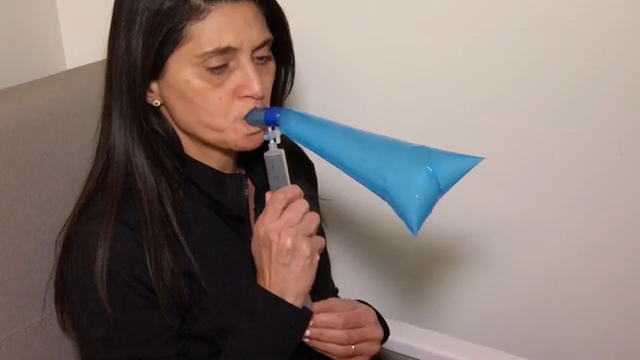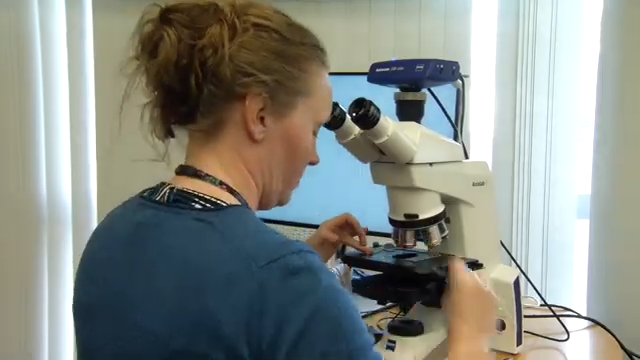RALEIGH, N.C. (Ivanhoe Newswire) — More than two million Americans have lost a limb and it’s estimated there are 185,000 amputations every year. Now new technology in prosthetics is helping many amputees move forward.
Robert Wright has kept his sense of humor despite losing his left leg to melanoma in 2018, but it wasn’t always this way.
“Lying in the hospital bed, getting ready for amputation, I was like this is going to be my life,” Wright said.
The former police officer wasn’t sure how to move forward. Until he walked into the Hanger Clinic in Raleigh, North Carolina. The team introduced Wright to the latest technology in prosthetic legs: the microprocessor-controlled knee.
“They have multiple sensors and it monitors the position of the knee in space. As the knee begins to bend, it’s reading those sensors very rapidly,” Steven Few, certified prosthetist and orthotist at Hanger Clinic, said.
Hydraulic pressure inside the knee allows more movement than previous prosthetics.
Adjustments can be made by computer or through an app, improving mobility and reducing the risk of falls.
“I stepped in a fire,” Qinghua Li said.
Li lost her leg in China at the age of two. She says her new knee allows her to keep up with her three-year-old son.
Li told Ivanhoe, “I notice that this is more stable than the old leg, and I can also go uphill and downhill.”
Jeremy Sanders, certified prosthetic assistant at Hanger Clinic, knows firsthand what these patients face since losing his leg in a factory accident at 19.
“I didn’t know how life would progress at that point,” Sanders said.
He’s dedicated his life to working with other amputees and even made Wright a special patriotic cover for his prosthetic.
“The microprocessor knee far exceeds my expectation of what I was going to be able to do in life,” Wright said.
One step at a time.
Wright dedicates his patriotic prosthetic to his son who is in the Navy and all of the U.S. servicemen and women out there who risk their lives every day. Steven says not every amputee is a candidate for a microprocessor knee and should be evaluated first. The new technology along with the fittings can cost up to $50,000 but we’re told most insurance companies cover the cost. Hanger Clinic has more than 750 locations across the country. For more information go to www.hangerclinic.com.
Contributors to this news report include: Cyndy McGrath, Executive Producer, Janna Ross, Producer; Roque Correa, Videographer and Editor.
To receive a free weekly e-mail on Medical Breakthroughs from Ivanhoe, sign up at: http://www.ivanhoe.com/ftk
MEDICAL BREAKTHROUGHS
RESEARCH SUMMARY
TOPIC: WALKING TALL WITH ADVANCED PROSTHETICS
REPORT: MB #4678
BACKGROUND: A prosthesis is the substitute limb worn by an amputee. Prosthetics refers to the field and science of creating prostheses. Leg amputations are performed either below or above the knee, and modern prostheses are customized to match the wearer’s lifestyle and grant them a full range of motion. Arm amputations are either above or below the elbow, and these prostheses allow the wearer to manipulate and grip objects, thus living more independent lives. Electric prostheses can even move based on signals from the wearer’s muscles.
(Source: https://www.amputee-coalition.org/prosthetics-types-guide/)
PROSTHETIC LEGS/ARMS: An exoskeletal prosthesis is made of wood or urethane foam with a hard plastic shell. It is heavier and less customizable than an endoskeletal prosthetic, but it is more durable and long-lasting. An endoskeletal prosthesis has an inner support pylon made of light-weight materials such as titanium or aluminum, with the feet and knees having the ability to be swapped out, making these easily adjustable for different activities and active lifestyles. For above-the-knee amputees, there are a variety of knee joint prosthetics available; the two basic types being single-axis knees and polycentric knees. Single-axis knees are of hinge-style, they can only bend forward or backward. Polycentric knees are also referred to as “fourbar” knees, and they can rotate on multiple axes. Below the elbow amputations are performed between the hand and the elbow, and prostheses are designed to replace the forearm, wrist, and hand. Above the elbow amputations, being that most of the arm is removed, a hybrid prosthesis is the best option to provide the motion of the elbow and also provide grip. There are body powered prosthetic arms with three-harness cable systems that allow the wearer to grasp objects, flex and lock the elbow. Then there are electrically powered prostheses which resemble a real arm and the user controls it with electrical impulses through the muscle into the residual limb. This option is more expensive than the body-powered one, and requires frequent charging and a great deal of fine-tuning to get it to interpret the electrical signals. This option may not work for all people.
(Source: https://www.amputee-coalition.org/prosthetics-types-guide/)
MICROPROCESSOR PROSTHETIC KNEES: Microprocessor knees are known to improve mobility while also reducing the risk of injury from falls. The technology is constantly evolving, offering wearers even smarter knees with improved sensors and longer battery life. The C-Leg Microprocessor knee controls both the swing and stance phases of gait. It allows the wearer to walk faster or slower, take on hills and go down stairs step-over-step. The revolutionary microprocessor inside receives feedback from its multiple sensors, which allows the knee to anticipate the next move and make adjustments in real time. This keeps the knee stable when weight is put on it, as well as free-swinging when a person steps through. When the C-Leg senses an insecure position, like a trip or stumble, it will stiffen to provide the support needed to recover. Once sensing that the wearer is secure again, it will offer normal reliable support. It has multiple modes and switching between modes, such as for walking or riding a bike and driving, and it’s as simple as bouncing on your toe or pressing the wireless remote control to switch modes.
FOR MORE INFORMATION ON THIS REPORT, PLEASE CONTACT:
Meghan Williams, Public Relations & Communications Program Manager
512-777-3701
If this story or any other Ivanhoe story has impacted your life or prompted you or someone you know to seek or change treatments, please let us know by contacting Marjorie Bekaert Thomas at mthomas@ivanhoe.com




